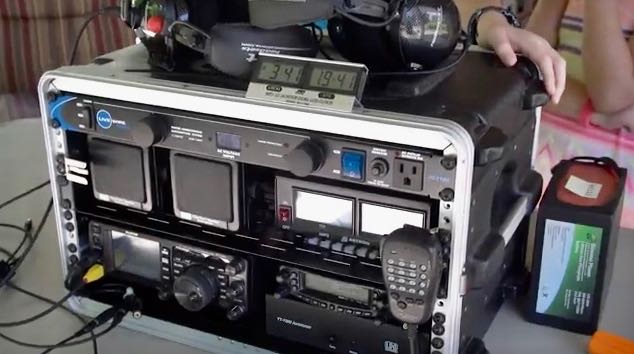Exploring the World of Portable Ham Radio:
Gear, Radios, and Power Options
Portable ham radio offers an exciting way for amateur radio enthusiasts to connect with others while on the move. Whether you’re a hiker, backpacker, or simply enjoy outdoor adventures, portable ham radio provides a reliable means of communication in remote areas. In this article, we’ll delve into the gear needed for portable ham radio, suggest a few radio options, and explore power alternatives such as Bioenno batteries and solar power for recharging. We’ll also discuss lightweight gear for those who prefer smaller radios and using CW (continuous wave) mode.
Gear for Portable Ham Radio:
When it comes to portable ham radio, having the right gear is crucial for a successful and enjoyable experience. Here are a few essential items to consider:
Radio: Choosing the right radio is the foundation of portable ham radio operations. Look for compact and lightweight options with built-in antennas or provisions for attaching external ones. Consider radios with extended battery life and a wide frequency range to support various ham radio bands.
Antenna: While built-in antennas are convenient, they may not always provide optimal performance. Investing in a portable antenna can significantly enhance your signal range and clarity. Lightweight wire antennas, such as dipole or end-fed antennas, are popular choices among portable operators.
Mast or Support: Carrying a lightweight mast or support system helps elevate your antenna, allowing for better signal propagation. Telescopic fiberglass or carbon fiber poles are portable and easy to set up. Additionally, some radios have provisions for attaching antennas to trekking poles, providing a versatile and space-saving solution.
Accessories: Don’t forget essential accessories like headphones, a keyer for CW operations, spare batteries, and a rugged carrying case to protect your gear from the elements.

Popular Portable Ham Radios:
Here are a few notable portable ham radios suitable for various outdoor activities:
Yaesu FT-818: The Yaesu FT-818 is a compact and versatile HF/VHF/UHF transceiver known for its robust performance. It covers a wide frequency range, supports multiple operating modes, and offers extended battery life. With its built-in antenna tuner and convenient form factor, the FT-818 is an excellent choice for portable operations.
Elecraft KX1, KX2 & KX3: The Elecraft KX1, 2 & 3 are lightweight and feature-packed HF transceivers designed specifically for portable use. They offer excellent receiver performance, intuitive controls, and a built-in antenna tuner. The KX series of radios compact size makes them ideal for hikers, backpackers, and mountain climbers.
Icom IC-705: The Icom IC-705 is a portable HF/VHF/UHF transceiver with advanced features and a compact design. It covers a broad frequency range, supports multiple operating modes, and has built-in GPS and Bluetooth capabilities. The IC-705’s rugged build and water-resistant construction make it suitable for outdoor adventures.
Power Options for Portable Ham Radio:
Ensuring a reliable power source is essential for extended portable ham radio operations. Here are a couple of power options to consider:
Bioenno Batteries: Bioenno Power offers lightweight and high-capacity lithium iron phosphate (LiFePO4) batteries specifically designed for ham radio use. These batteries provide long-lasting power, are incredibly safe, and have a longer cycle life compared to traditional lead-acid batteries. Bioenno batteries are available in various capacities to suit different power requirements.
Solar Power: Utilizing solar power for recharging batteries is an eco-friendly and sustainable option. Compact and foldable solar panels can be easily carried in backpacks and can charge batteries during daylight hours. Ensure compatibility with your battery’s voltage and consider panels with higher conversion efficiency for optimal results.
Lightweight Gear for Mountain Climbers and CW Operators:
For mountain climbers or those seeking minimalist setups, there are options tailored to their needs. Compact radios that support CW mode can significantly reduce weight and power consumption. Here’s a suggestion for lightweight gear:
- Elecraft KX1: The Elecraft KX1 is an ultralight CW transceiver designed for maximum portability. It is small enough to fit in your pocket and operates on a low power output. With its simple interface and excellent receiver performance, the KX1 is perfect for those who prioritize light gear and Morse code communications.
- Some other lightweight radio considerations would be Yaesu FT-891 (if you want 100 watts, but you will sacrifice weight), The LNR Precision Mountain Topper radios are fantastic and very popular among the SOTA folks, the only problem is the are hard to get a hold of but much cheaper option than the Elecrafts.
Conclusion:
Portable ham radio offers the thrill of exploring the great outdoors while staying connected to the amateur radio community. By investing in the right gear, such as compact radios, portable antennas, and lightweight power options like Bioenno batteries or solar panels, you can embark on memorable adventures with reliable communication capabilities. Whether you’re hiking in the mountains or enjoying a weekend getaway, portable ham radio ensures you’re never far from the camaraderie of fellow operators worldwide.
